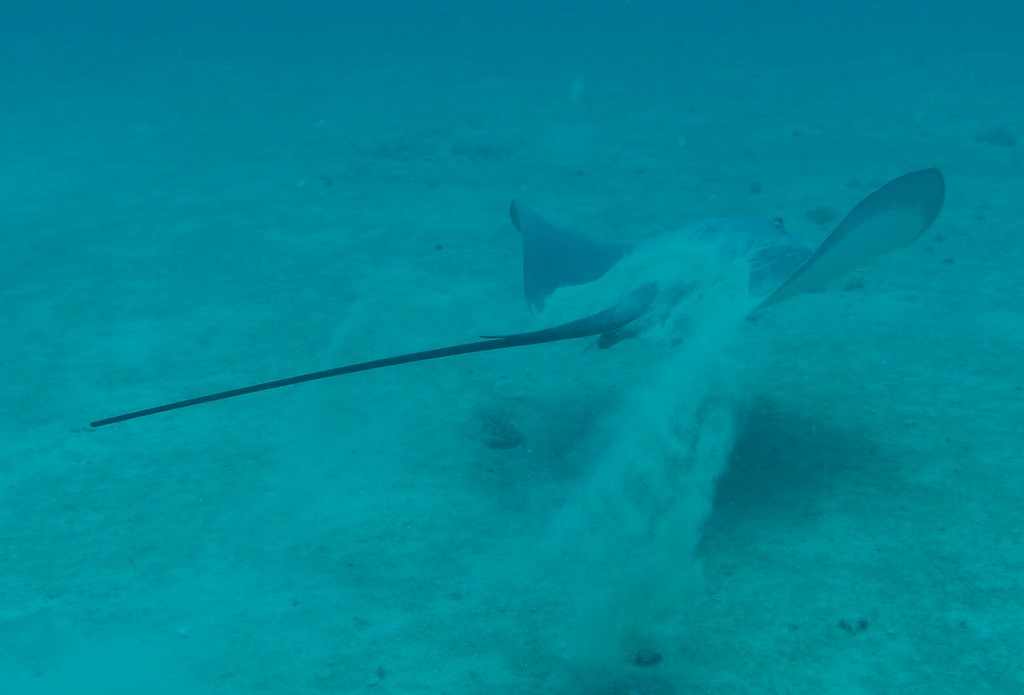HIMANTURA FAI - (JORDAN & SEALE, 1906)
Chordata (Phylum) > Vertebrata (Subphylum) > Gnathostomata (Superclass) > Pisces (Superclass) > Elasmobranchii (Class) > Neoselachii (Subclass) > Batoidea (Infraclass) > Rajiformes (Order) > Dasyatidae (Family) > Himantura (Genus)
Pink whip ray, Pink whipray, Raie fouet, raie à longue queue, Lila pijlstaartrog, Trnucha růžová
-----------------------------
Description
Disc rhomboidal, very robust centrally, quadrangular, width 1.1 to 1.2 times length; pectoral-fin apex broadly rounded; snout very broad, tip feebly pointed; anterior margin straight to slightly convex. Tail very long (about twice disc width), base rather narrow, almost cylindrical in cross-section; whip-like behind sting; mostly with single sting. Eyes small, length of eye and spiracle about 2.6 in preorbital snout length; interorbital space broad. Mouth moderately small, 4 papillae on floor (central pair enlarged, laterals minute); labial furrows and corrugations prominent. Internasal flap skirt-shaped, short, and very broad, not papillate, marginal fringe very fine; nostrils long, very narrow; lower jaw slightly concave near symphysis. Pelvic fins small, relatively slender. No cutaneous folds. Denticles of adults rounded, dense, extending from well before eye, over central disc, and mostly covering entire tail; no enlarged thorns on midline; small, sharp, upright thorns on tail beyond sting. In juveniles, disc surface and tail mostly smooth, or with low, flat, widely spaced, heart-shaped denticles extending from interorbital space posteriorly over centre of disc and onto midline of tail. Max length : 183 cm. max. published weight: 18.5 kg.
Colour
Upper surface greyish pink; ventral surface uniformly pale; tail dark greyish or black beyond sting.
Biotop
Inhabits lagoon and seaward sand flats from the intertidal to at least 200 m. Occurs in large aggregations.
Etymology
Himantura: Greek, iman, imantos = thong, strap + Greek, oura = tail.
Distribution
Indo-Pacific. Reported from New Caledonia. Possibly widespread from South Africa to Micronesia.
Possible synonym of Himantura gerrardi. Frequently confused with Himantura jenkinsii (the tail is shorter).
Biology
Occurs in aggregations over soft bottoms of the inner continental shelf, often near coral reefs. Ovoviviparous. Size at birth at about 55 cm wide diameter. Common catch of the demersal tangle net, bottom trawl and, to a lesser extend, longline fisheries. Utilized for its meat, skin (high value) and cartilage. By-catch of prawn trawlers.
Pink whip ray, Pink whipray, Raie fouet, raie à longue queue, Lila pijlstaartrog, Trnucha růžová
-----------------------------
Description
Disc rhomboidal, very robust centrally, quadrangular, width 1.1 to 1.2 times length; pectoral-fin apex broadly rounded; snout very broad, tip feebly pointed; anterior margin straight to slightly convex. Tail very long (about twice disc width), base rather narrow, almost cylindrical in cross-section; whip-like behind sting; mostly with single sting. Eyes small, length of eye and spiracle about 2.6 in preorbital snout length; interorbital space broad. Mouth moderately small, 4 papillae on floor (central pair enlarged, laterals minute); labial furrows and corrugations prominent. Internasal flap skirt-shaped, short, and very broad, not papillate, marginal fringe very fine; nostrils long, very narrow; lower jaw slightly concave near symphysis. Pelvic fins small, relatively slender. No cutaneous folds. Denticles of adults rounded, dense, extending from well before eye, over central disc, and mostly covering entire tail; no enlarged thorns on midline; small, sharp, upright thorns on tail beyond sting. In juveniles, disc surface and tail mostly smooth, or with low, flat, widely spaced, heart-shaped denticles extending from interorbital space posteriorly over centre of disc and onto midline of tail. Max length : 183 cm. max. published weight: 18.5 kg.
Colour
Upper surface greyish pink; ventral surface uniformly pale; tail dark greyish or black beyond sting.
Biotop
Inhabits lagoon and seaward sand flats from the intertidal to at least 200 m. Occurs in large aggregations.
Etymology
Himantura: Greek, iman, imantos = thong, strap + Greek, oura = tail.
Distribution
Indo-Pacific. Reported from New Caledonia. Possibly widespread from South Africa to Micronesia.
Possible synonym of Himantura gerrardi. Frequently confused with Himantura jenkinsii (the tail is shorter).
Biology
Occurs in aggregations over soft bottoms of the inner continental shelf, often near coral reefs. Ovoviviparous. Size at birth at about 55 cm wide diameter. Common catch of the demersal tangle net, bottom trawl and, to a lesser extend, longline fisheries. Utilized for its meat, skin (high value) and cartilage. By-catch of prawn trawlers.
